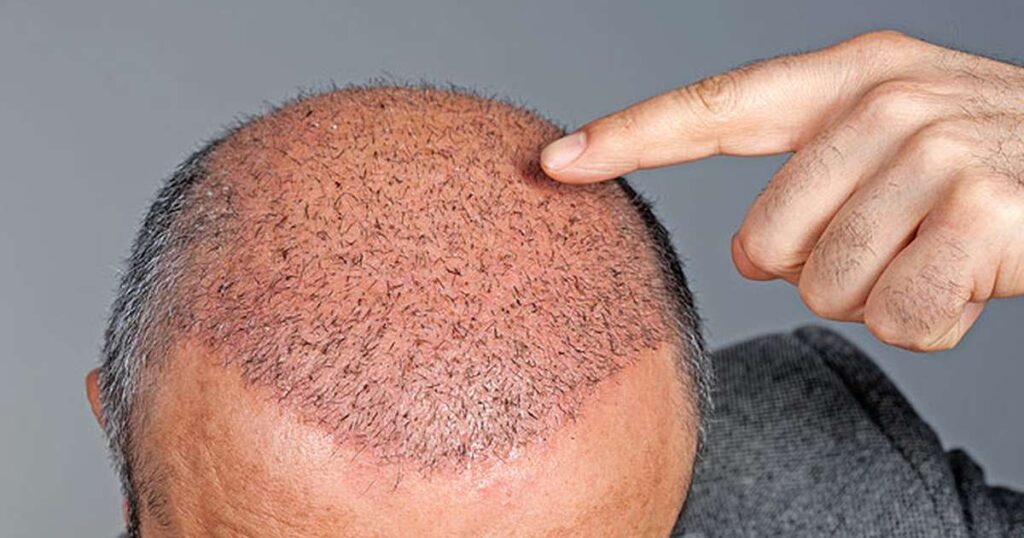Follicular unit extraction (FUE) hair transplants are done by taking individual hair follicles out of your skin and implanting them elsewhere on your body. This will make the hair in the new area look thicker.
FUE was meant to replace the “classic” follicular unit transplantation (FUT) technique. This procedure was done by taking an entire piece of skin or scalp along with the follicles and transplanting the skin on the target area.
FUE has become more popular than FUT because it’s less likely to lead to a “hair plug” look, where sections of skin or hair don’t match the surrounding areas. It also won’t leave a large scar like FUT does.
The best candidate for a FUE hair transplant is someone with thinning hair or balding who still has enough hair nearby to use for a transplant.
You may not be eligible for a FUE hair transplant if you don’t have enough healthy or thick hair to transplant to the thinning or balding area.
A FUE hair transplant costs between $4,000 and $15,000 per session. A multiple-session procedure may cost up to $50,000 or more.
The ultimate cost of a FUE hair transplant depends on:
You’ll likely need to pay for a FUE hair transplant out of pocket because most health insurance plans don’t cover cosmetic procedures like this.
You’ll also need to cover prescription medications for pain or other possible side effects that may result from the procedure.
You should factor in time off work for recovery when considering the cost. This can mean 3 to 4 days at home. Most companies don’t cover hair transplants under medical leave policies.
As you get older, the three-phase cycle of hair growth and regrowth shortens until follicles no longer regrow hairs.
This process is different for everyone. Some people start balding in their 20s, while others bald much later in life.
FUE hair transplants restore hair by replacing these old follicles with new follicles that are still able to grow hair.
After the transplant, the follicles will be nourished by blood vessels and begin growing hair in the area that previously had thin hair or balding.
Here’s how the FUE procedure works:
FUE hair transplants are most commonly performed on the scalp.
They can also be done elsewhere on your body where hair is thin or absent. FUE can be done on your arms, legs, and even your genital area.
You won’t experience any scars from a FUE hair transplant other than tiny white dots where follicles were taken out. These may fade over time.
See your doctor if you notice any of the following rare side effects:
Recovery from FUE is quick. You may have some swelling or discomfort for about 3 days.
Here are some aftercare instructions your doctor may give you:
Some hairs may fall out during the healing process. This is normal. You’ll probably start to notice a difference after 3 to 4 months.
Depending on the health of your transplanted hair, your hair may not grow back as thick as expected.
Here are some photos of what you can expect from a FUE hair transplant.
Here are some things you may need to do before getting a FUE hair transplant:
Try the International Society of Hair Restoration Surgery’s (ISHRS) Find a Doctor tool to locate a physician who specializes in hair restoration near you.
You can also use the directory on the American Board of Hair Restoration Surgery’s (ABHRS) website to find a doctor who’s certified in hair restoration based on the rigorous criteria of the ABHRS.
Last medically reviewed on July 14, 2020
5 sourcescollapsed
A hair transplant is a procedure where hair follicles are taken from different parts of your head and moved to areas of thinness or baldness.
During a hair transplant, a surgeon moves hair from a hair-filled section of the head to a bald area. Transplants are mostly used to address baldness…
There are two hair transplant procedures that have largely replaced the “hair plugs” of old. But both come with side effects, and neither is…
A hair transplant is the best way to get more hair on your head. But how much does a hair transplant cost? Learn about the factors that affect the…
Maybe you’ve been looking for a way to lose weight quickly but have concerns about side effects. This article explores how the Optavia diet may cause…
A receding hairline in Black men can happen for many reasons. We explore the causes, diagnosis, treatment, and more.
Whether your hair loss is a result of a health condition or pattern baldness, there are things you can do to protect the hair that you have.
Actor Matthew McConaughey has touted Regenix as a hair restoration product for two decades, but some experts are skeptical about its effectiveness
MSM is a sulfur compound known for its anti-inflammatory effect. It may also support hair growth. Learn about its uses and potential side effects.
OUR BRANDS
DHA Flagship Clinic
190 DD Block Commercial Area, Next to Jamia Mosque Phase 4 DHA Lahore Pakistan
UAN : 03-111-077-111
Just Give Us a Call For Any Kind Of Queries We Are Here For You
Timings
Monday - Saturday
9:00am To 9
:00pm
Sunday 12:00pm To 6:00pm
If You Have Any Kind Of Query Just Give Us a Call
About Us
Our goal is to be the Gold Standard of skin care and cosmetic surgery in South Asia. I personally see every new patient who visits our clinic. I am Board Certified by the American Board of Dermatology, American Board of Internal Medicine and American Academy of Cosmetic Surgery.
Gulberg Branch
Ground Floor, 34 MM Alam Rd, behind Pizza Hut, Block B1 B-1 Gulberg III, Lahore, Punjab 54600, Pakistan
DHA Flagship Clinic
190 DD Block Commercial Area, Next to Jamia Mosque Phase 4 DHA Lahore Pakistan
Johar Town Branch
445 G 4 Block Main Boulevard Near Khokhar Chowk Johar Town Lahore Pakistan
2004-2022 All Rights Are Reserved © cosmetique.com.pk

